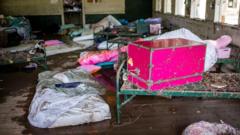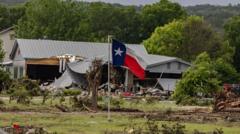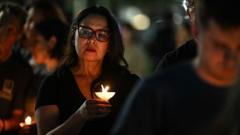Years before tragic flooding claimed 27 lives at Camp Mystic, U.S. regulators reportedly allowed the camp's buildings to be removed from high-risk flood zone maps. Experts and officials now question the implications of this decision on safety, while flood warnings and preparedness are scrutinized in the aftermath of a devastating natural disaster in Texas.
Controversy Surrounding Camp Mystic Flood Mapping Before Tragic Incident

Controversy Surrounding Camp Mystic Flood Mapping Before Tragic Incident
Reports reveal that Camp Mystic, a children's summer camp in Texas, was removed from official flood risk maps, raising questions about safety measures before a deadly flood.
Years before the catastrophic floods that resulted in the deaths of 27 children at Camp Mystic, official reports indicate that U.S. regulators approved the removal of several camp buildings from Federal Emergency Management Agency (FEMA) flood risk maps. This has led to significant backlash and raised questions regarding safety protocols for facilities housing minors.
According to articles by the New York Times and the Associated Press, Camp Mystic was initially classified as being at a high risk of flooding in FEMA's 2011 maps. However, it successfully challenged this designation in the subsequent years. The camp is situated in a low-lying area along the Guadalupe River, which is particularly susceptible to flooding. Post-tragedy inquiries noted that many of Camp Mystic's cabins were designated within a "floodway", classified as a hazardous area for expected floodwaters. Additional cabins fell into zones expected to flood once every century, necessitating flood insurance and stringent construction regulations.
Expert opinions, including those from Syracuse University associate professor Sarah Pralle, highlight concerns about the camp’s exemption status. Pralle expressed her astonishment over the allowances made for a children's camp, suggesting that stricter precautions should have been a priority. "You'd think you want to be extra cautious - that you'd go beyond the minimum of what's required for flood protection," she stated.
The tragedies unfolded when floodwaters overwhelmed the camp just before dawn on July 4th. Alongside the 27 young girls who lost their lives, floods claimed at least 129 lives across Texas, with many still missing. President Donald Trump visited affected areas, pledging government assistance for rebuilding efforts, but faced criticism for responding dismissively to inquiries about preemptive warning measures prior to the flooding.
As investigations continue, the focus remains on how the mapping decisions and the timing of the severe weather contributed to one of Texas' most devastating flood incidents. Experts emphasize the need to scrutinize both the infrastructure in flood-prone regions and the efficacy of emergency response protocols to prevent such tragedies in the future.

















